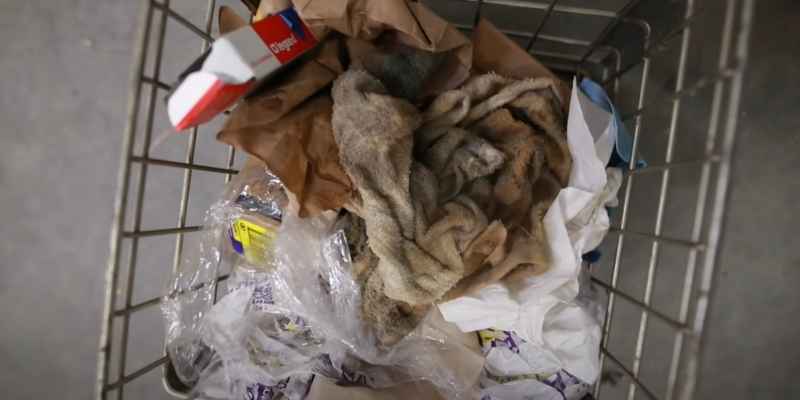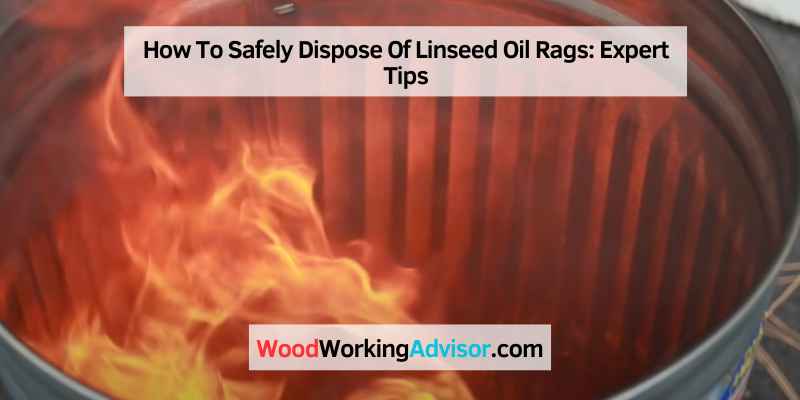To dispose of linseed oil rags, lay them flat outdoors to dry completely, then dispose of them in a metal container with a lid, or place them in water to soak before discarding them. Linseed oil rags can pose a fire hazard due to their potential to spontaneously combust.
Therefore, it is crucial to handle their disposal carefully. We will discuss the proper way to dispose of linseed oil rags to ensure safety and minimize risks. By following these steps, you can avoid potential accidents and protect both yourself and the environment.
So, let’s delve into the details of linseed oil rag disposal.
Why Proper Disposal Is Important
Proper disposal of linseed oil rags is crucial to prevent the risk of spontaneous combustion and potential fire hazards. Ensure you dispose of these rags safely following local regulations to protect yourself and the environment.
Fire Hazard
Leaving linseed oil-soaked rags lying around can pose a significant fire hazard. Linseed oil is highly flammable, and improper disposal methods can result in spontaneous combustion. This occurs when the oil reacts with atmospheric oxygen, causing a chemical reaction that generates heat. Over time, this heat can build up within the rag and potentially ignite the surrounding environment once it reaches the oil’s flashpoint of about 480 degrees Fahrenheit.
Environmental Impact
Proper disposal of linseed oil rags is also important to minimize their negative impact on the environment. Linseed oil is composed of natural compounds that break down slowly, and improper disposal can lead to leaching of these compounds into the soil and water systems. This can contaminate groundwater and harm aquatic life if not handled correctly.
Additionally, burning linseed oil-infused rags releases harmful fumes and pollutants, contributing to air pollution. These pollutants can adversely affect human health and contribute to respiratory issues such as asthma and other breathing difficulties.

Understanding Linseed Oil Rags
When it comes to using linseed oil for various purposes, it is essential to understand the proper disposal methods for linseed oil rags. Linseed oil is a popular natural finish for wood, creating a beautiful, smooth, and durable surface. However, linseed oil rags can be a fire hazard due to their ability to self-ignite. In this section, we will explore the properties of linseed oil and the dangers associated with linseed oil rags, providing you with the knowledge you need to handle and dispose of them safely.
Properties Of Linseed Oil
Linseed oil, also known as flaxseed oil, is derived from the seeds of the flax plant. It has been used for centuries as a wood finish, due to its ability to penetrate deeply into the wood, enhancing its natural grain and color. Linseed oil is a drying oil, meaning it hardens over time when exposed to air. This makes it an ideal choice for protecting and preserving wood surfaces, such as furniture, decks, and floors.
Some key properties of linseed oil are:
- Penetrative: Linseed oil has the ability to penetrate deep into the wood, nourishing it from within.
- Durable: Once dried, linseed oil creates a durable protective layer that can withstand regular wear and tear.
- Natural: Linseed oil is a natural, non-toxic finish that is safe for both indoor and outdoor use.
- Enhancing: It enhances the natural beauty of wood, bringing out its grain and color.
Dangers Of Linseed Oil Rags
While linseed oil has many beneficial properties, linseed oil rags can pose a significant danger if not handled and disposed of properly. The drying process of linseed oil produces heat, and when the oil-soaked rags are left in a pile, this heat can build up and lead to spontaneous combustion, resulting in a fire.
Here are some dangers associated with linseed oil rags:
- Self-Ignition: Linseed oil rags have the potential to self-ignite if not properly handled and disposed of.
- Fire Hazard: Improperly stored or discarded linseed oil rags can cause fires, endangering lives and property.
- Smoke and Toxic Fumes: Burning linseed oil produces smoke and toxic fumes that can be harmful to your health.
Due to these risks, it is crucial to understand the safe disposal methods for linseed oil rags. By following the proper guidelines, you can prevent accidents and ensure the well-being of yourself, others, and the environment.
Safety Precautions
Dispose of linseed oil rags safely by first laying them flat to dry, then storing them in a sealed container or disposing of them in a fire-resistant container. This precaution prevents spontaneous combustion and reduces the risk of fire.
Using A Metal Container
When it comes to disposing of linseed oil rags, it is crucial to follow safety precautions to prevent the risk of fire. One important step in ensuring safety is using a metal container to store the used linseed oil rags.
Why a metal container? Linseed oil, also known as flaxseed oil, is highly prone to spontaneous combustion when exposed to oxygen. This means that if left in contact with air, the oil-soaked rags can generate heat and eventually catch fire on their own.
Therefore, using a metal container is essential as it helps contain the heat and restricts oxygen supply to the rags. Metal is non-combustible, making it the ideal choice for storing potentially hazardous materials like oil-soaked rags.
Here’s how to proceed:
- Choose a metal container that has a tight-fitting lid to further minimize the risk of fire. Ensure that the container is made of non-combustible material, such as steel or aluminum.
- Place the linseed oil rags carefully inside the metal container, making sure they are not tightly packed. Leave some space for air circulation.
- Once the rags are inside, close the lid tightly to prevent any air from entering the container. This step is crucial in avoiding any oxygen supply to the rags, reducing the risk of combustion.
Avoiding Heat Sources
Aside from using a metal container, another safety precaution to follow when disposing of linseed oil rags is avoiding heat sources.
Heat can catalyze the process of oxidation, wherein the linseed oil rags react with oxygen in the air. This can accelerate the generation of heat and increase the risk of spontaneous combustion.
Here’s what you need to keep in mind:
- Avoid storing the metal container near any heat sources, such as furnaces, radiators, or heaters. Make sure the container is placed in a cool and well-ventilated area.
- Do not expose the storage area to direct sunlight, as excessive heat can build up and increase the chances of fire.
- If you are storing the container in a garage or shed, ensure that it is not placed near any electrical outlets or devices that generate heat.
By avoiding heat sources and maintaining a cool environment, you significantly reduce the risk of spontaneous combustion of linseed oil rags.
Disposal Methods
When it comes to disposing of linseed oil rags, it’s important to follow appropriate methods to prevent any accidents or environmental hazards. Here are three effective disposal methods you can use:
1. Air Drying
A simple and effective way to dispose of linseed oil rags is by air drying them. Start by laying the rags flat in a well-ventilated area, away from any flammable materials or heat sources. Be sure to spread them out to allow proper airflow and prevent overheating. Leave the rags to dry completely, which may take approximately 24 to 48 hours, depending on the ambient temperature and humidity levels. Once the rags are fully dried, you can safely dispose of them in the regular trash.
2. Seal And Dispose
If air drying is not a feasible option for you, sealing and disposing of linseed oil rags can be an alternative. To do this, place the used rags in a metal container with a tight-fitting lid, such as a metal paint can or an old coffee tin. Ensure the container is made of a non-combustible material to prevent any fire hazards. After sealing the container tightly, label it with a clear warning label indicating that it contains linseed oil rags. Finally, contact your local waste management facility to inquire about their regulations for disposing of such hazardous waste. Follow their instructions for proper disposal.
3. Contact Hazardous Waste Facility
If you have a large quantity of linseed oil rags or are unsure of the proper procedures for disposal, it is recommended to contact a hazardous waste facility. These facilities specialize in the safe disposal of potentially dangerous materials and can guide you on the correct steps to take. Search for a hazardous waste facility near you and contact them to explain your situation. They will provide you with expert advice and arrange for the proper collection and disposal of the linseed oil rags, ensuring safety and compliance with environmental regulations.
Best Practices
When it comes to disposing of linseed oil rags, it’s important to follow the best practices to ensure the safety of your workspace and avoid any potential risks. Here are some H3 headings that outline the essential steps to take:
Store In A Well-ventilated Area
Properly storing linseed oil rags is crucial to prevent heat buildup and potential fire hazards. After using the rags, find a well-ventilated area to store them. Do not leave them bunched or piled together as this can generate heat and increase the risk of combustion.
If you have a spacious workspace, consider installing racks or hooks on the wall to hang the linseed oil rags individually. This will allow for better airflow and minimize the chances of ignition. Alternatively, you can use a sturdy metal container with a tight-fitting lid to store the rags safely.
Properly Label Containers
When it comes to proper disposal, labeling the containers appropriately is crucial to minimize potential risks and confusion. Ensure each container that holds linseed oil rags is clearly labeled with a warning sign indicating the presence of oil-soaked materials.
Use bright, bold fonts for the labels to ensure they are easily visible and attention-grabbing. Additionally, include a brief description of the contents to further emphasize the importance of handling them with caution.
By adhering to these best practices, you can effectively dispose of linseed oil rags while maintaining a safe working environment.

Frequently Asked Questions For How To Dispose Of Linseed Oil Rags
How Do You Dispose Of Linseed Oil Cloths?
Dispose of linseed oil cloths by spreading them out in a well-ventilated area to dry completely. Once dry, place the cloths in a metal container, like a can with a tight-fitting lid. Fill the container with water, sealing it tightly.
Dispose of the container at a hazardous waste facility.
What To Do With Linseed Soaked Rags?
Store linseed soaked rags in airtight metal containers or spread them out to dry completely to prevent spontaneous combustion. Do not leave them in piles or dispose of them in regular trash. Proper handling prevents fire hazards.
Can Linseed Oil Rags Combust?
Yes, linseed oil rags can combust due to the heat generated during the drying process. Proper care must be taken to prevent spontaneous combustion by storing used rags in a well-ventilated area or soaking them in water before disposing of them.
How Do You Dispose Of Oily Rags After Oil Change?
Dispose of oily rags after an oil change by placing them in a fireproof container with a tightly sealed lid. Then, take them to a local recycling or hazardous waste facility. Proper disposal helps prevent fires and protects the environment.
Conclusion
Proper disposal of linseed oil rags is crucial to prevent fire hazards and environmental damage. By following these safe practices, you can ensure a secure and eco-friendly approach to dealing with linseed oil-soaked rags. Don’t forget to store them in a well-ventilated metal container and dispose of them in accordance with local regulations.
Remember, responsible disposal protects both you and the environment.


